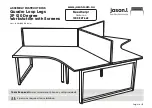
7
The
digiLiVE
8C
features 6 mono
Mic
/line input channels (each with XLR/TRS jack
combination connectors and switchable phantom power); stereo
L
eft and
R
ight line-level
inputs (TRS jack or stereo minijack); and one stereo
USB Input
for music playback (mp3 or
WAV files). Two balanced XLR stereo
Mix Outputs
(
L
eft and
R
ight) allow you to connect to
active loudspeakers or to a power amplifier and loudspeakers. Two separate internal busses
(
FX1
and
FX2
) feed the onboard effects (
REV
erb and
DEL
ay) and two auxiliary outputs
(
AUX1
and
AUX 2
) are provided to enable you to create separate stage monitor mixes
and/or additional front of house (FOH) mixes. Alternatively, you could use these outputs to
feed external effects units whose outputs could be returned to the
digiLiVE
either through
the analogue stereo
L-R
input or via one or two mic/line inputs. A stereo
Headphone
output
provides local monitoring of inputs and outputs. Two
Footswitch jacks
allow you to connect
two footswitches to switch FX on and off.
INPUTS
Mic
These XLR/TRS jack combination inputs can accept microphone (XLR) and line-level (TRS
jack) signals. These inputs feed analogue preamplifiers capable of delivering 60dB of gain,
which is controlled by rotary
Gain
knobs. The position of these knobs cannot be stored or
recalled as part of a console scene.
The XLR inputs can each supply individually-switchable 48V phantom power for condenser
microphones. This means that you can switch off phantom power to an input and safely plug
in XLR microphone-level inputs from DI boxes, external preamplifiers etc. A good rule of
thumb is to only switch on phantom power when it is required. A
Red LED
on each channel
indicates that phantom power is active on that channel. On the
digiLiVE 4C
the phantom
power is switched via hidden switch that can be accessed with a paperclip or similar tool.








































